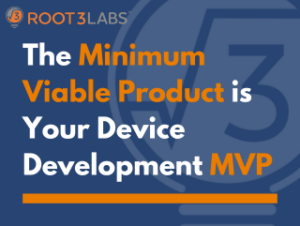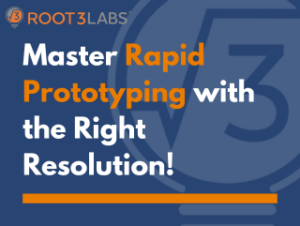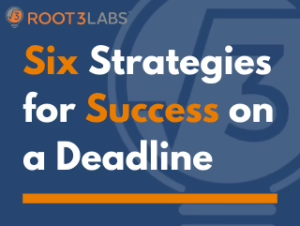Product Development Efficiency: CEO Insights and Strategies for Effective Engineering
As someone who is both impatient and detail-oriented, I’ve spent years thinking about product development efficiency. Sometimes getting it right, and sometimes learning the hard way.
I’m sure you can relate. Your team is tackling new problems every day. And, of course, these problems are never simple, easy, or even well-defined. But that doesn’t mean you have to play whack-a-mole with new problems daily. We can be efficient about finding solutions.
I often struggle to explain efficiency without falling back on weird analogies. My favorite is: “efficiency isn’t about moving your fingers faster – it’s about moving them only as much as they need to move.”
But, recently, I’ve realized I might have been thinking about it all wrong. Keep reading to:
- Learn the difference between busy and productive
- Discover 4 practical strategies for device development
- Get a simple decision-making framework for engineering teams
Understanding the Efficiency Paradox in Product Development
I could spend my entire day managing projects, designing mechanical components, or maintaining machines in our prototyping workshop. I’m efficient at all of these tasks after decades of experience – but, as CEO, that wouldn’t be helping Root3 Labs become a better company. It’s not an effective effort.
This is where decision making becomes crucial. As Seth Godin wisely noted, “You don’t need more time…you just need to decide.” When faced with multiple ways to spend your time, the real challenge isn’t doing things faster – it’s choosing which things deserve your attention in the first place.
You know those days when you feel incredibly busy but haven’t accomplished anything meaningful? That’s the efficiency paradox in action.
Efficiency Trap
- Working Faster
- Managing Multiple Projects
- Constant Busy Work
Effectiveness Solution
- Working Smarter
- Focusing on Key Impacts
- Strategic Prioritization
When you’re deciding how to spend your resources (time, money, people), it’s tempting to focus on doing things faster. That’s efficiency, right?
But, it’s more important to apply your effort wisely, work on things that matter, and continue moving toward clear goals. That’s effectiveness.
4 Key Strategies for Improving Product Development Effectiveness
1. Adopt a Risk-First Approach
- By tackling the riskiest parts of a problem first, resources are focused where they matter most.
- Tasks like building a board enclosure may be time consuming, but it’s not risky. It can wait until later on, after all the other components have been confirmed.
2. Embrace Minimalism in Device Design
- This approach isn’t about cutting corners, but about being strategic with when and where to invest your team’s time and expertise.
- Start with the minimum viable solution that meets your requirements, then iterate and add complexity based on validated needs rather than assumptions.
3. Adhere Strictly to Regulatory Requirements
- In MedTech, regulatory compliance is not optional. It’s critical to maintain thorough documentation without getting bogged down in unnecessary details.
- Every decision should tie back to your design requirements and regulatory framework.
4. Encourage Collaborative Problem-Solving
- Don’t keep spinning your wheels on the same problem for too long.
- If you’ve consulted the manual, called the manufacturer, and spent an hour researching online without progress – it’s time to ask for help.
Balancing Quality and Speed in Product Development
In product development, we cannot sacrifice quality for speed. The trick is to find the right balance between thorough development and efficient processes.
Strategic Decision-Making for Effective Product Development
In a regulated industry like MedTech, some decisions require extensive analysis and documentation. However, plenty of others don’t. The real skill is in knowing the difference.
Here’s a simple framework I use:
- Will this decision significantly impact safety or efficacy? – If yes, take the time needed.
- Is this decision easily reversible? – Then make it quickly and move on.
- Are you stuck between two similar options? – Just pick one and proceed.
- Does the decision affect regulatory compliance? – If so, make sure to follow established protocols.
Remember: time spent deciding is time not spent doing. While some decisions deserve deep consideration, most deserve quick resolution so you can focus on execution.
Streamlining Processes without Sacrificing Product Quality
Focus on maintaining quality where it matters most – in areas that affect safety, efficacy, and regulatory compliance. Other aspects can often be streamlined without compromising the final product.
Maintain the “Is It Necessary?” Mindset
Before starting any task, ask yourself: Is this necessary right now? Does this move us closer to our goal? Sometimes a quick sketch communicates an idea better than a detailed CAD model.
Shifting Perspectives on Product Development Efficiency
The key to better product development efficiency isn’t working faster – it’s working smarter. Focus on effectiveness first, then optimize for efficiency where it makes sense.
Written By: Chad Schneider, MSE, P.E.
Download Our Guide to Product Development!
Want more insights on improving your Product Development process? Access practical strategies for boosting your development efficiency.




